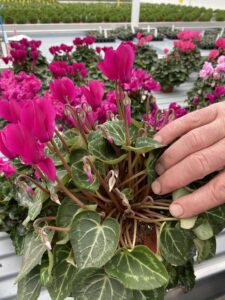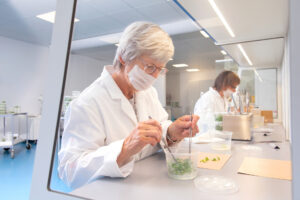BLOG: Everything you need to know about Cyclamen
Cyclamen have been popular plants since the dawn of floriculture, and the cheerful flowers are still conquering the hearts of consumers. It’s high time to have a deeper look at the world of cyclamen, and see what we can find out. Schoneveld Breeding, the breeder of a whole range of well-known cyclamen, opened its doors to Javado Magazine.
The origins of Super Series
Every Javado customer viewing the range of cyclamen on our web shop has probably noticed that many species have the name Super Series, sometimes abbreviated to SS, in their description. All the species developed by Schoneveld Breeding bear this brand name.
Schoneveld is a longstanding family of growers from the east of the Netherlands. The original nursery grew into a commercial nursery. Patty Schoneveld used to visit florists in the 1980s with his truck full of plants. Every florist had the same essential tip: always go for the highest quality plants. Patty searched out the best varieties, and the nursery took the first steps in breeding. In the early 1990s, this resulted in a cyclamen with 165 flowers! He managed to propagate this cyclamen and sell it to the florists, who were incredibly enthusiastic.
However, Patty wanted to go beyond supplying just florists. The cyclamen was one of the best-known pot plants at the time, so a complete chain of breeding and propagation organisations already existed. How do you get your toe in the door? He took a bold step, and gave cyclamen growers some batches of young plants to grow. When they found out that these plants got the best prices at the auction, they realised that this was the series they had to grow.
Another smart move Patty made was being the first to develop a label with a brand name that was attached to every plant. This rapidly generated demand from the market.
So, how did the name Super Series come about? Basically, Patty couldn’t describe these plants other than super, so he called them Super Series.
A closer look at the genetics of the cyclamen

“Cyclamen growers know that breeder’s blood is essential to grow cyclamen. The genes of our Super Series are so good, however, that they do away with a number of problems: all the plants are uniform, they bloom very abundantly, and you don’t have to remove flowers that appear too early. Our motto used to be: with our genes, everyone can grow top-quality cyclamen. That didn’t go down well with the proud growers, so we quickly abandoned it. Let’s just say that our cyclamen are both a pleasure to grow, and a pleasure to buy or be given.”
Why were various Super Series developed?
I’m impressed with the Super Serie Original, but there are now lots of other series, such as the Verano, Picasso, Allure, Jive, etc. Why so many? Why not stick to one series everyone knows? Rather a stupid question to ask, of course, but it got an interesting answer:
“There are two reasons behind the structure of our series. One is to develop novelties, such as cyclamen with a unique appearance. Examples include the beautiful Merengue and the unusual Petticoat.
The main reason, however, is all about the changing seasons and the related needs of cyclamen. That’s why our series include the Verano, the Carino and the Mini Winter series, even though these are similar in appearance. It works as follows. In the summer, it’s dry, warm, and daylight hours are long. In the autumn, it’s humid, and in winter, there’s much less light. A specific season actually requires a specific type of cyclamen. This solution means we can help growers cultivate top-quality products at all times, and provide consumers with sustainable cyclamen regardless of the season.”
Behind the scenes at the breeder
Schoneveld Breeding’s impressive greenhouse complex has been in use for two years now. It’s designed so that visitors can personally experience the processes at this breeder.

Then we take a look at the seed processing. Schoneveld Breeding’s core business is cyclamen seeds. This is what the company supplies to propagators, who germinate the seed in plugs. These develop into the young plants that are sent to cyclamen growers for cultivation. Although Schoneveld doesn’t supply growers directly, there’s a lot of direct contact to share experiences and cultivation advice.
The greenhouses are divided into areas to produce seed for the commercial varieties and areas to develop new varieties.
When we arrive at the greenhouse where the seed is extracted for production, I notice how much manual work is involved. The greenhouse is full of cyclamen. The petals of the flower are pulled off before they really bloom. The pistils, which are left, are then fertilised. It results in a seed box with about 100 seeds.
Published on: 17 September 2020